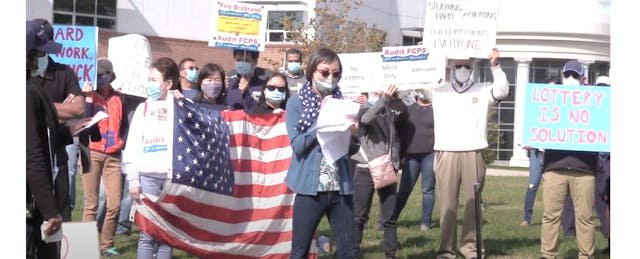Every year, around the country, high school students get their hands dirty with science projects—chemistry labs, robotics, that model of a volcano.
But one school just outside of Washington, D.C., Thomas Jefferson High School for Science and Technology, was the first where students designed a satellite that was actually launched into space.
And that's just one example of how extraordinary this school is. After all, it holds the top spot on the U.S. News and World Report ranking of public high schools.
If you’re wondering, yeah, it’s a public school, not one of those private schools with tuition as high as a college. And as a public school, it should be open to all the students in the district.
And that's where the problem lies.
Not surprisingly more students want to go there than the school has slots for. A lot more. About 500 new freshmen matriculate to Thomas Jefferson every year out of roughly 3,000 that apply. That means for every 6 students that apply, just 1 gets a spot.
So who gets to go?
For decades, that question has largely been decided by a test. A special science and math test developed specifically for the school.
That approach fits with perhaps the most popular narrative of American education, that the best students get to go to the best schools. For a long time in this country, that has just seemed to make sense.
But in the case of Thomas Jefferson, or TJ as it’s known, the approach has detractors—increasingly, a lot of them.
That’s because the current admissions system leaves out nearly all of the Black and Hispanic students in the area. While about 27 percent of the district is Hispanic and 10 percent is Black, each group makes up just 2 percent of the student body at TJ.
After the murder of George Floyd by Minneapolis police a year ago, momentum grew to try to reform the admissions process at the school to try to make the process more fair, and the student body more diverse.
And last fall, the Fairfax County Public School Board proposed a radical change to the TJ admissions process: Scrapping the admissions test to replace it with a lottery of students who meet a minimum academic standard.
That change has sparked a feisty battle between groups of parents and alumni, including protests and rallies, lawsuits and passionate arguments at school board meetings.
If you're thinking this is sounding a little like that podcast Nice White Parents, you're not wrong. But there are some important differences here. For one thing, many of the most vocal opponents of the changes to TJ admissions aren’t white. They’re recent immigrants, many from China and India.
In fact, the majority of the TJ student body are Asian-American. And they’re quoting America’s founding fathers, arguing that the ones who are getting in are simply the ones studying the hardest, and that the current system is fair.
On this week’s EdSurge Podcast, we take you inside the debate, focusing on the dueling narratives of educational equity that have emerged. It is the second in our series of episodes called Bootstraps: Merit, Myths and Education. We're co-producing this podcast series with our friends at the journalism nonprofit Open Campus.
You’ll hear rocket launches, protests, and those feisty school board debates. But we also sat down for longer conversations with two parents on opposing sides, both immigrants with children in the school system.
The two sides can sound far apart, so we tried to bring these two parents together for a moderated discussion. And though they found some common ground, they kept disagreeing about which story of the American Dream should be told when building a public education system.
Listen to the episode on Apple Podcasts, Overcast, Spotify, Stitcher, Google Play Music, or wherever you listen to podcasts, or use the player on this page.


